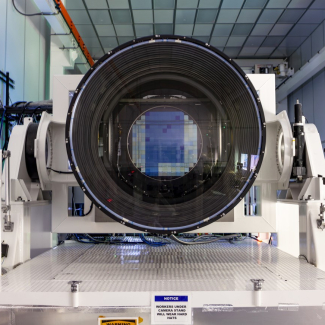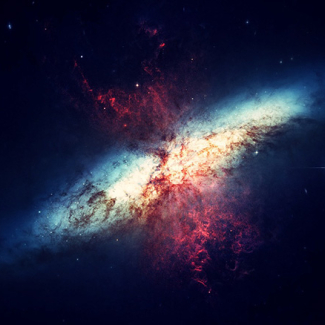
Machine learning: a breakthrough in the study of stellar nurseries
Artificial intelligence can make it possible to see astrophysical phenomena that were previously beyond reach. This has now been demonstrated by scientists from the CNRS, IRAM, Observatoire de Paris-PSL, Ecole Centrale Marseille and Ecole Centrale Lille, working together in the ORION-B1 programme. In a series of three papers published in Astronomy & Astrophysics on 19 November 2020, they present the most comprehensive observations yet carried out of one of the star-forming regions closest to the Earth.
The gas clouds in which stars are born and evolve are vast regions of the Universe that are extremely rich in matter, and hence in physical processes. All these processes are intertwined on different size and time scales, making it almost impossible to fully understand such stellar nurseries. However, the scientists in the ORION-B programme have now shown that statistics and artificial intelligence can help to break down the barriers still standing in the way of astrophysicists.
With the aim of providing the most detailed analysis yet of the Orion molecular cloud, one of the star-forming regions nearest the Earth, the ORION-B team included in its ranks scientists specialising in massive data processing. This enabled them to develop novel methods based on statistical learning and machine learning to study observations of the cloud made at 240 000 frequencies of light2 .
Based on artificial intelligence algorithms, these tools make it possible to retrieve new information from a large mass of data such as that used in the ORION-B project. This enabled the scientists to uncover a certain number of ‘laws’ governing the Orion molecular cloud.
For instance, they were able to discover the relationships between the light emitted by certain molecules and information that was previously inaccessible, namely, the quantity of hydrogen and of free electrons in the cloud, which they were able to estimate from their calculations without observing them directly. By analysing all the data available to them, the research team was also able to determine ways of further improving their observations by eliminating a certain amount of unwanted information.
The ORION-B teams now wish to put this theoretical work to the test, by applying the estimates and recommendations obtained and verifying them under real conditions. Another major theoretical challenge will be to extract information about the speed of molecules, and hence visualise the motion of matter in order to see how it moves within the cloud.

© J. Pety/ORION-B Collaboration/IRAM
Quantitative inference of the H2 column densities from 3mm molecular emission: A case study towards Orion B. Pierre Gratier, Jérôme Pety, Emeric Bron, Antoine Roueff, Jan H. Orkisz, Maryvonne Gerin, Victor de Souza Magalhaes, Mathilde Gaudel, Maxime Vono, Sébastien Bardeau, Jocelyn Chanussot, Pierre Chainais, Javier R. Goicoechea, Viviana V. Guzmán, Annie Hughes, Jouni Kainulainen, David Languignon, Jacques Le Bourlot, Franck Le Petit, François Levrier, Harvey Liszt, Nicolas Peretto, Evelyne Roueff and Albrecht Sievers. A&A, November 19, 2020.
Tracers of the ionization fraction in dense and translucent gas: I. Automated exploitation of massive astrochemical model grids. Emeric Bron, Evelyne Roueff, Maryvonne Gerin, Jérôme Pety, Pierre Gratier, Franck Le Petit, VivianaGuzman, Jan H. Orkisz, Victor de Souza Magalhaes, Mathilde Gaudel, Maxime Vono, Sébastien Bardeau, PierreChainais, Javier R.Goicoechea, Annie Hughes, Jouni Kainulainen, David Languignon, Jacques Le Bourlot,François Levrier, Harvey Liszt, Karin Öberg, Nicolas Peretto, Antoine Roueff and Albrecht Sievers. A&A, November 19, 2020.
C18O, 13CO, and 12CO abundances and excitation temperatures in the Orion B molecular cloud : An analysis of the precision achievable when modeling spectral line within the Local Thermodynamic Equilibrium approximation. Antoine Roueff, Maryvonne Gerin, Pierre Gratier, François Levrier, Jérôme Pety, Mathilde Gaudel, Javier R.Goicoechea, Jan H. Orkisz, Victor de Souza Magalhaes, Maxime Vono, Sébastien Bardeau, Emeric Bron, Jocelyn Chanussot, Pierre Chainais, Viviana V. Guzman, Annie Hughes, Jouni Kainulainen, David Languignon, Jacques Le Bourlot, Franck Le Petit, Harvey S. Liszt, Antoine Marchal Marc-Antoine Miville-Deschênes, Nicolas Peretto, Evelyne Roueff and Albrecht Sievers. A&A, November 19, 2020.
Contact
Notes
- Standing for Outstanding Radio-Imaging of OrioN B. The scientists involved are from the Laboratoire d’Etudes du Rayonnement et de la Matière en Astrophysique et Atmosphères (Observatoire de Paris – PSL/CNRS/Sorbonne Université/Université de Cergy-Pontoise), Institut de Radioastronomie Millimétrique (IRAM), Centre de Recherche en Informatique, Signal et Automatique de Lille (CNRS/Université de Lille/Centrale Lille), Institut de Recherche en Astrophysique et Planétologie (CNRS/CNES/Université Toulouse III Paul Sabatier), Institut de Recherche en Informatique de Toulouse (CNRS/Toulouse INP/Université Toulouse III Paul Sabatier), Institut Fresnel (CNRS/Aix-Marseille Université/Centrale Marseille), Laboratoire d'Astrophysique de Bordeaux (CNRS/Université de Bordeaux), du Laboratoire de Physique de l'Ecole Normale Supérieure (CNRS/ENS Paris/Sorbonne Université/Université de Paris), Laboratoire Grenoble Images Parole Signal Automatique (CNRS/Université Grenoble Alpes), Instituto de Física Fundamental (CSIC) (Spain), National Radio Astronomy Observatory (United States), Chalmers University of Technology (Sweden), Cardiff University (United Kingdom), Harvard University (United States), Pontificia Universidad Católica de Chile (Chile).
- The observations were made using one of IRAM’s radio telescopes, the 30-metre antenna located in Spain’s Sierra Nevada.


